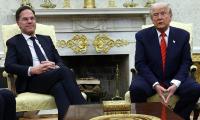According to the Pakistan Education Statistics Report 2016-17, almost 23 million children are out of school in the country. This means that the state and society have failed to ensure the right to education for these children.
The seriousness of the issue becomes palpable when these numbers are disaggregated into various levels of education based on provincial areas and gender. Except for the primary level, there are more children out of school than in school at middle, high and higher secondary levels. In all these levels of compulsory education, 49 percent of girls are out of school as compared with 40 percent of boys. Similarly, 70 percent of children are out of school in Balochistan, 34 percent in Khyber Pakhtunkhwa and 57 percent in the now-defunct tribal belt of the country.
For any nation or society that cares about its future, this situation should be extremely disconcerting. Every child who doesn’t get an opportunity to develop her/his abilities produces a deficit for our future. Unfortunately, for those who compile statistics and can read the ensuing reports, these millions merely represent a string of numbers. The children of those who generate and consume these reports mostly attend private schools. Therefore, these statistics seem quite distant to such people.
When a child runs towards our cars at a traffic signal to clean windscreens, sell trinkets or beg for money, we seldom think that one out of the millions of people counted in these annual reports is in standing front of us. Spotting a child working at a dhaba doesn’t take away our thirst and appetite. We also don’t get perturbed when we see children working as domestic workers in our homes as well as the homes of our relatives and friends.
It is time we stopped undermining millions of life trajectories as mere numbers. We should start connecting our thoughts on Sustainable Development Goals (SDGs) and worries about out-of-school children – a majority of whom are young girls. In the current scenario, when the nation is going to the polls, our political environment is charged with promises from all mainstream political parties for a prosperous future for everyone.
We should seek clear commitments from the parties that we support for equitable and quality education coupled with feasible action plans. The rosy picture of a prosperous nation will remain a dream if it is not scaffolded by well-thought-out strategies to educate all children and address the vast gender parity gaps beyond primary school enrolments.
All provincial governments are reviewing, updating and revising their education sector plans for the next phase of the five-year planning cycle. This is an opportunity to think, plan and allocate resources to ensure the right to quality education for all citizens of Pakistan. Recently, Balochistan’s education department participated in a workshop on gender-responsive education planning and budgeting. During this event, participants analysed the need for a gender analysis of education sector plans. They came up with strategies and action plans to make the Balochistan Education Sector Plan more gender-responsive.
Other provincial governments should also initiate a deeper conversation that can help those working on education sector planning to integrate equity in each part and sub-part of their sector plans. More importantly, they should identify how existing human, financial and material resources can be used more effectively to meet our commitment for equity and determine where extra resources will be required.
The UN secretariats in Europe and the US will analyse our educational data and set targets that Pakistan must achieve. Development partners in European and North American capitals will also try to support us in achieving these targets where they are aligned with their foreign policy objectives. International NGOs will vie for available funds to do limited activity in the country while subsidising their costly homes and country offices.
All these efforts will be ineffective if custodians of the education system in political and bureaucratic offices in Pakistan don’t lead the agenda to ensure that everyone gains an education. The ‘education for all’ slogan makes us complacent when an increase in enrolment at the primary level shows some progress. We need to change our slogan to ‘education for everyone’ so that we account for individuals when assessing our progress.
This is the only way forward for us because every one of the million or more children who are either out of schools or don’t have access to quality education at school are our future. They will construct the social, political, economic and cultural facets of our society. These facets will be shared by children from elite private schools, public schools, madressahs and those who don’t attend school.
Our streets, neighbourhoods, offices, businesses, mosques, parks and roads will be collectively inhabited by them and will only remain peaceful when the gaps in socioeconomic statuses are not an outcome of the apathy shown towards the denial of basic rights to a few people.
The writer is an education adviser at the Aga Khan Foundation Pakistan.
People of that time believed that an eclipse was a symbol of displeasure of gods
Vertically speaking, dominance of domestic debt in Pakistan’s debt portfolio is haunting
Loss of biodiversity is stark reminder that urban mismanagement is not just infrastructural failure but ecological...
Strong public warning systems can also help ensure quick evacuations in places prone to fires
PPPs in Pakistan's WASH sector face significant regulatory and policy challenges that hinder their effectiveness
Instead, it would have powerful chairman with three-year term, appointed at prime minister’s discretion







